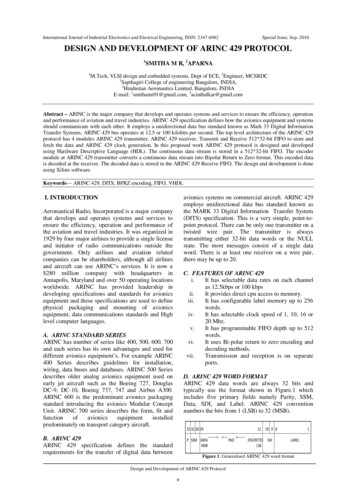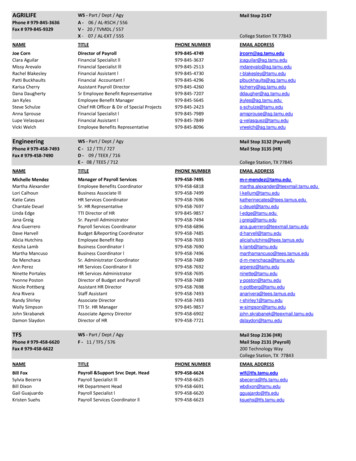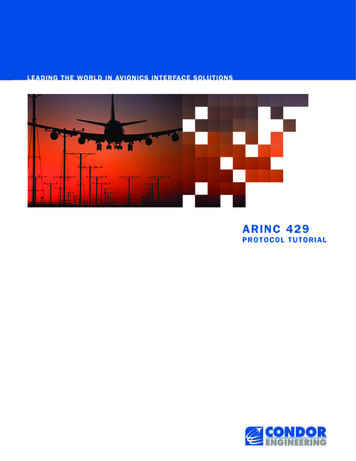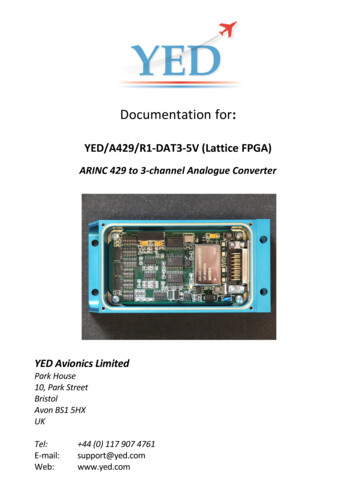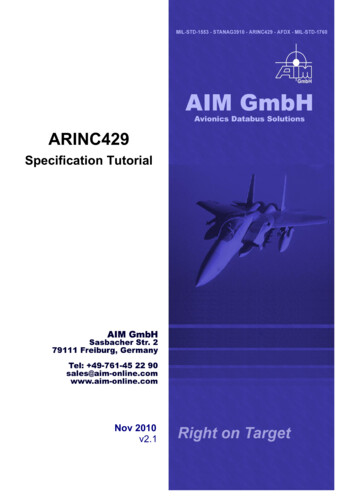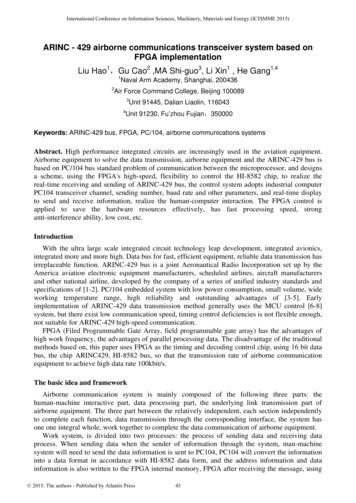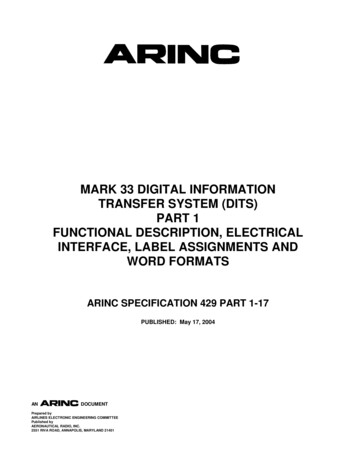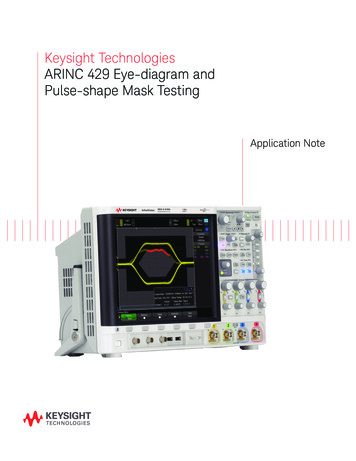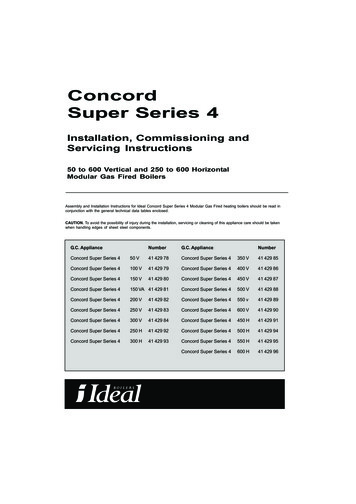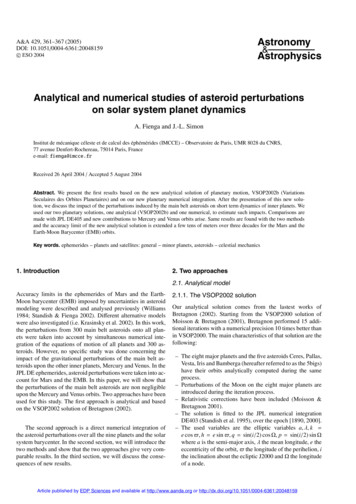
Transcription
Astronomy&AstrophysicsA&A 429, 361–367 (2005)DOI: 10.1051/0004-6361:20048159c ESO 2004 Analytical and numerical studies of asteroid perturbationson solar system planet dynamicsA. Fienga and J.-L. SimonInstitut de mécanique céleste et de calcul des éphémérides (IMCCE) – Observatoire de Paris, UMR 8028 du CNRS,77 avenue Denfert-Rochereau, 75014 Paris, Francee-mail: fienga@imcce.frReceived 26 April 2004 / Accepted 5 August 2004Abstract. We present the first results based on the new analytical solution of planetary motion, VSOP2002b (VariationsSeculaires des Orbites Planetaires) and on our new planetary numerical integration. After the presentation of this new solution, we discuss the impact of the perturbations induced by the main belt asteroids on short term dynamics of inner planets. Weused our two planetary solutions, one analytical (VSOP2002b) and one numerical, to estimate such impacts. Comparisons aremade with JPL DE405 and new contributions to Mercury and Venus orbits arise. Same results are found with the two methodsand the accuracy limit of the new analytical solution is extended a few tens of meters over three decades for the Mars and theEarth-Moon Barycenter (EMB) orbits.Key words. ephemerides – planets and satellites: general – minor planets, asteroids – celestial mechanics1. Introduction2. Two approaches2.1. Analytical modelAccuracy limits in the ephemerides of Mars and the EarthMoon barycenter (EMB) imposed by uncertainties in asteroidmodeling were described and analysed previously (Williams1984; Standish & Fienga 2002). Different alternative modelswere also investigated (i.e. Krasinsky et al. 2002). In this work,the perturbations from 300 main belt asteroids onto all planets were taken into account by simultaneous numerical integration of the equations of motion of all planets and 300 asteroids. However, no specific study was done concerning theimpact of the gravitational perturbations of the main belt asteroids upon the other inner planets, Mercury and Venus. In theJPL DE ephemerides, asteroid perturbations were taken into account for Mars and the EMB. In this paper, we will show thatthe perturbations of the main belt asteroids are non negligibleupon the Mercury and Venus orbits. Two approaches have beenused for this study. The first approach is analytical and basedon the VSOP2002 solution of Bretagnon (2002).The second approach is a direct numerical integration ofthe asteroid perturbations over all the nine planets and the solarsystem barycenter. In the second section, we will introduce thetwo methods and show that the two approaches give very comparable results. In the third section, we will discuss the consequences of new results.2.1.1. The VSOP2002 solutionOur analytical solution comes from the lastest works ofBretagnon (2002). Starting from the VSOP2000 solution ofMoisson & Bretagnon (2001), Bretagnon performed 15 additional iterations with a numerical precision 10 times better thanin VSOP2000. The main characteristics of that solution are thefollowing:– The eight major planets and the five asteroids Ceres, Pallas,Vesta, Iris and Bamberga (hereafter referred to as the 5bigs)have their orbits analytically computed during the sameprocess.– Perturbations of the Moon on the eight major planets areintroduced during the iteration process.– Relativistic corrections have been included (Moisson &Bretagnon 2001).– The solution is fitted to the JPL numerical integrationDE403 (Standish et al. 1995), over the epoch [1890, 2000].– The used variables are the elliptic variables a, λ, k e cos , h e sin , q sin(i/2) cos Ω, p sin(i/2) sin Ωwhere a is the semi-major axis, λ the mean longitude, e theeccentricity of the orbit, the longitude of the perihelion, ithe inclination about the ecliptic J2000 and Ω the longitudeof a node.Article published by EDP Sciences and available at http://www.aanda.org or http://dx.doi.org/10.1051/0004-6361:20048159
362A. Fienga and J.-L. Simon: Analytical and numerical studies of asteroid perturbationsTable 1. Maximum differences between VSOP2002 (Bretagnon 2002)and DE403 over [1890–2000]. Units are 10 10 AU for a, 10 10 radianfor λ and 10 10 for k, h, q, 34.910.80.51.18.026.3For each planet or asteroid, we introduce the mean mean longitude as a linear function of time t, λ̄P λ0P nP t where λ0Pand nP are the integration constant of the mean longitude andthe mean motion of the planet or of the asteroid, respectively.Each elliptic variable, used to describe the motion, is developedin Poisson series of the mean mean longitudes of the perturbedand perturbing objects (the eight major planets and the five asteroids) and of the three Delaunay’s angles of the Moon. Theseries are developed up to degree 8 with respect to time.Unfortunately Bretagnon did not have time to complete hiswork. Nevertheless the comparison of his last results to DE403shows a real progress compared to VSOP2000. Table 1 givesthe maximum differences between VSOP2002 and DE403 over[1890, 2000]. VSOP2002 is better than VSOP2000 by a factorof between 3 and 10 for Mercury, Venus and the EMB, and between 1.5 and 3 for Jupiter and Saturn. For Mars, the accuracyis the same because the perturbations by 295 asteroids includedin DE403 and DE405 (Standish 1998) are not taken in accounteither in VSOP2000 or in VSOP2002. However, VSOP2002is worse than VSOP2000 for Uranus and Neptune because theperturbations from Pluto are not taken into account.2.1.2. VSOP2002b, improvement of the VSOP2002solutionIn the VSOP2002 solution, we have introduced the followingimprovements:– We have added the perturbations of Pluto on the outer planets in the form of Poisson series of only one argument,namely a linear function of time, as explained in Simon(2004). With those perturbations, the results of Table 1are improved by about a factor of 2 for Uranus and 5 forNeptune.– We have computed the perturbations due to the J2 of theSun on the planets Mercury, Venus, the EMB and Mars.They are mainly secular perturbations for the variablesk, h, q, p. The formulae for computing those perturbationsare standard (see, for instance, Lainey 2002; or Pitjeva2001a). With the value of J2 given by DE405 (2 10 7), wecomputed the secular perturbations k, h, q, p given inTable 2. These perturbations explain completely the secularTable 2. Secular perturbations for the variables k, h, q, p of Mercury,Venus, the EMB and Mars due to the J2 of the Sun (2 10 7 ). Unit is10 10 by 1000 years.Planet k h q p 2459.7547.3 192.4 306.9Venus 6.4 5.7 41.111.0EMB 6.5 1.5 24.86.3Mars3.68.0 4.60.5Mercurydrifts between VSOP2000 and DE405 found by Moisson(2000) for the variables k, h, q, p of Mercury.– We have introduced the perturbations induced by 295 moreasteroids as described in Sect. 2.1.3.– We have computed new integration constants for the analytical solution by comparison with the JPL numerical integration DE405 (Standish 1998), over [1890, 2000].The resulting analytical solution, fitted to DE405, is calledVSOP2002b.2.1.3. Perturbation by the asteroidsPrevious works (Mignot 2002; Williams 1984) have studied asteroid perturbations by analytical methods. In Mignot (2002),the perturbations induced by about 400 asteroids upon Mars orbit were estimated to the first order of mass. For each variableand for each couple Mars-asteroid, the perturbations have theform of a Fourier series of the mean mean longitudes of Marsand of the asteroid.In the present work, we rather computed the perturbationsin a more compact form, based on Poisson series of only oneargument, µ, described by Simon (2001). If nj and nS denote themean motions of Jupiter and Saturn, then µ is given by µ (nj nS )t/880 0.359536t where t is given in thousands of years.µ is a 17 485 year period argument. It is also the argument ofthe Poisson series corresponding to the perturbations by Plutoadded to VSOP2002.We have applied this formulation to the 295 asteroids, besides the 5bigs, chosen by Williams (1984) as the most perturbative asteroids of the Mars orbit. We have computed the perturbations of these asteroids on Mercury, Venus, EMB, Marsand Jupiter as follows. First, we computed by harmonical analysis (Simon 1987) the first order perturbations for each variableand each couple planet-asteroid in the form of Fourier series ofthe mean mean longitude of the planet and of the asteroid. Eachargument of the Fourier series has the form iλ̄P jλ̄A where iand j are integers and λ̄P and λ̄A are the mean mean longitudes of the planet and of the asteroid, respectively. We writeinP jnA qµ t where q is an integer and where is as smallas possible. Using this relation, we transform the Fourier seriesof the mean mean longitudes in Poisson series of µ. We add,for each variable of each planet, the Poisson series given by allthe asteroids. Finally, we obtain the analytical perturbations ofthe 295 asteroids in a very simple form: for each variable ofthe planets Mercury, Venus, the EMB, Mars and Jupiter, these
A. Fienga and J.-L. Simon: Analytical and numerical studies of asteroid perturbations363Table 3. Secular perturbations for the variables k, h, q, p of Mercury, Venus, the EMB and Mars due to the asteroids given by VSOP2002b andthe Numerical integration (NI). The NI drifts are estimated by comparison to DE405, only for Mercury and Venus. Unit is 10 10 by 1000 years.PlanetMercuryVenusEMBMars kVSOP 42.62.2 6.3176.4NI 47.00.8 hVSOP8.8 12.4 29.4176.9perturbations are given by only one Poisson series of only oneadditional argument µ (exactly as the perturbations by Pluto)and are then easy to introduce in the VSOP solution. We havecomputed the series with the precision of VSOP2002, keepingall the terms inducing contributions greater than 0.5 10 12 radover 1000 yr. With this accuracy, the series corresponding tothe perturbations on the mean longitudes of Venus, EMB, Marsand Jupiter contain 55, 295, 2760 and 1500 terms respectively.For Mercury, there are only secular terms. For Mars, the differences between this new solution, VSOP2002b and DE403are decreased by a factor of between 2 and 5, depending on thevariable, compared to the results shown in Table 1. The asteroids give also significant secular perturbations k, h, q, pfor all these planets. In the following (see Sect. 2.3), we will seethat those secular terms also have been detected by another independant method, the comparison between DE405 and a newnumerical integration developed at the IMCCE. Table 3 givesthe values of these secular perturbations for Mercury, Venus,EMB and Mars given by the analytical theory and for Mercuryand Venus by numerical integration. The asteroids give alsosecular perturbationsof the variable related to the mean lon gitude λ by λ ndt where n is the mean motion. The secular trends produce significant changes in the integration constants of the semi-major axis. For the planets Mercury, Venus,EMB and Mars, these secular perturbations are respectively 312 10 10 rad over 1000 yr, 812 10 10 rad over 1000 yr, 1420 10 10 rad over 1000 yr and 3364 10 10 rad over1000 yr. These values are similar to those obtained by Pitjeva(2004). These changes in the semi-major axis have the sameeffects as changes in the secular part of the mean longitudesand produce significant modifications of the motions of theseplanets.2.2. Numerical integrationTo integrate numerically the planetary equations of motion,we used an algorithm developed by Moshier (1992), based onan Adams-Cowell integrator. Planetary perturbations are computed as described in Newhall et al. (1983) and we addedthe perturbations induced by the asteroids and by the solaroblateness.The effects of the Sun J2 were added following the usualformulae (i.e. Sinclair & Taylor 1985) applied in the plan ofthe Sun’s equator. In Table 2, we present the drifts in the innerplanet orbits induced by the introduction of the solar oblatenessin the computation of the gravitational potential of the Sun, estimated by analytical analysis. These drifts are the signature qVSOP7.010.1 15.4 5.6NI9.2 14.4NI10.217.3 pVSOP 11.6 6.7 4.8 52.8NI 14.9 -5-5019001950k2000190019502000qFig. 1. Differences between our numerical integration without asteroidperturbations included in Mercury orbit and DE405 in (k, h, q, p) forthe Mercury orbit. The remaining drifts are quite small compared tothose presented in Table 2 and induced by the lack of modeling of thesolar oblateness.of a lack of modeling of the solar oblateness. As one can seein Fig. 1, no important drifts can be detected in the comparison between our numerical solution of the Mercury orbit andDE405 after the introduction of the J2 perturbations. The remaining drifts are not significant compared to those presentedin Table 2.Concerning the asteroids, the 5bigs are integrated separately from the main integration of the planetary perturbations.The perturbations of the nine planets upon these asteroids aretaken into account and integrated using a Burlich-Stoer integrator. From the deduced positions and velocities, Chebychevpolynomials are built and used in the main integration, associated with the DE405 asteroid mass determinations, to estimateand include the 5bigs perturbations upon the 9 planets.Furthermore, we added to the main integration the accelerations upon all nine planets induced by the 295 asteroids selected by Williams (1984). To estimate such accelerations, weused asteroid positions computed from mean orbits (Williams1984) and asteroid masses deduced from taxonomic densitiesand diameters given by JPL (Standish 1998).
364A. Fienga and J.-L. Simon: Analytical and numerical studies of asteroid perturbationsThe next step of our numerical integration evolution willbe its complete fit to space tracking, radar, VLBI and opticalobservations. The adjustement process is currently being finalysed. However, to simulate such an observational fit, a firstpreliminary fit was done on the JPL DE405 fitted to observations solution over an interval from 1970 to 2003. This intervalrepresents time during which the most accurate and the mostweighted observations are avaliable. It corresponds to the beginning of the Viking tracking data and to the end of the avaliable MGS and Mars Odyssey observations.2.3. Comparison to DE405We have estimated the impact of the asteroid perturbations bycomparison with the JPL DE405 solution. The JPL DE405 solution integrates separately the orbits of Ceres, Pallas and Vestaunder their own gravitational forces, those of the Sun, the planets and the Moon. The orbits of the other 297 asteroids (Irisand Bamberga included) are also integrated separately underthe gravitational action of the Sun, the planets, Ceres, Pallas,Vesta and the Moon. However, only the force vectors of these297 asteroids upon Mars and the EMB as well as their contributions to the solar system barycenter were computed andincluded in the main planetary integration. Thus, there are twokinds of differences between our solutions and DE405. Firstly,we did not compute the orbits of the 300 asteroids in exactly thesame way (see Sects. 2.2 and 2.1). Secondly, unlike the DE405model, we included the asteroid perturbations on all planets andnot only on Mars, the EMB and the solar system 900195020001900h 195020001900k NI-DE40519502000k VSOP2004-DE405Fig. 2. Differences between our numerical integration (NI) and DE405(left-hand plots) and VSOP2002b and DE405 (right-hand plots) in(k, h) variables for the Mars orbit. The thick line is for a numericalintegration or an analytical solution without the 295 asteroid perturbations. The thin line shows the differences between DE405 and thenumerical integration or the analytical solution including the 295 asteroid 0510052.4. Mars and the EMBIn DE405, in VSOP2002b and in our numerical integration,the Mars and the EMB orbits have been computed taking intoaccount the perturbations of 300 asteroids. However, the computation of the asteroid orbits used to estimate the perturbations on Mars and the EMB was not done in the same way. Inour analytical and numerical solutions, we used mean orbits of295 asteroids and we integrated numerically and analyticallythe perturbations of the Sun and the planets over Ceres, Pallas,Vesta, Iris and Bamberga. In DE405, the mutual perturbationsof Ceres, Pallas and Vesta were included and the orbits of the297 other asteroids (Iris and Bamberga included) were integrated numerically, and not only deduced from mean elementsas in our solutions.In Fig. 2, the differences between our numerical integration,VSOP2002b and DE405 are plotted in k and h. As one can see,the numerical integration (NI) and VSOP2002b have very similar behaviours compared to DE405. In Fig. 3, the differences inMars heliocentric distances also show the consistent results ofthe two solutions relative to DE405. Concerning the EMB heliocentric distances, one can see that the numerical integrationgives differences to DE405 2 times smaller than VSOP2002b.Nevertheless, the VSOP2002b shows an accuracy compared toDE405 of about ten meters over 30 years for both the Mars andthe EMB orbit. Such precision is quite satisfying for an EMBanalytical solution. In Fig. 3, the differences in Mars and EMB2000h 990200019801990200010100500-5-100197019801990Mars: DE403-DE40520001970EMB: DE403-DE405Fig. 3. Differences in meters for the Mars and EMB heliocentric distances between our numerical integration (thick line), VSOP2002b(thin line) and DE405 (upper plots) and DE403 and DE405 (lowerplots).heliocentric distances between our solutions and DE405 are atthe same level of magnitude as the previous JPL planetary solutions DE403 compared to DE405. This result is very interesting
A. Fienga and J.-L. Simon: Analytical and numerical studies of asteroid -1000-200-200-2001900195020001900h 1900hh 000-150-200190019502000k NI-DE4051900195020001900Fig. 4. Differences between our numerical integration (NI) and DE405(left-hand side plots) and VSOP2002b and DE405 (right-hand sideplots) in (k, h) variables for the Venus orbit. The thick line showsdifferences between DE405 and our numerical integration without the295 asteroid perturbations included in the Venus orbit. The thin lineshows the differences with 295 asteroid perturbations included in ournumerical integration of the Venus orbit.for the analytical solution of the Mars motion. It shows that ananalytical modeling of such a complex orbit is possible withvery good accuracy. We stress that the accuracy limit of theanalytical solution has not yet been achieved. Improvements,especially those induced by the new iteration process will leadto even better accuracy. As it was shown in Pitjeva (2001a) theasteroid orbits computed with the mean elements of 295 asteroids by Williams (1984) over a very long time interval differsignificantly from their true orbits, demonstrating the necessityof integrating the orbits of 300 asteroids in the future. Such animprovement has already been implemented in the next versionof our numerical solution to be published in 2005.1950kk VSOP2004-DE4052000190019502000qFig. 5. Differences between our numerical integration and DE405 in(k, h, q, p) for the Mercury’s orbit. The thick line shows differencesbetween DE405 and our numerical integration without asteroid perturbations included in Mercury orbit. The thin line shows the differenceswith the 295 asteroid perturbations included in our numerical integration of the Mercury orbit.introduction of the 295 asteroid perturbations upon the innerplanet analytical orbits can be compared to the drifts obtainedby comparison between our numerical integration and DE405.These figures are quite comparable. If we keep in mind thatthe analytical solution and the numerical integration are twoindependent methods of orbit computations then these comparisons show that the estimated drifts are real and not due to amismodeling of the analytical solution or the numerical integration. They also reveal the non-negligible impact of the mainbelt asteroids on the Mercury and Venus orbits. In Fig. 6, onecan see the impact of such perturbations in terms of Mercuryheliocentric distances over 30 years.3. Discussion2.5. Mercury and VenusThe second difference between our solutions and DE405 comesfrom the introduction of the 295 asteroid accelerations in thecomputation of the forces upon the Mercury and Venus orbits.Analytically, it was estimated that such an introduction inducesdrifts in (k, h, p, q) variables of the perturbed orbit. These driftsare gathered in Table 3. The comparisons between our numerical integration and DE405 show such drifts, as one can seein Fig. 4 for the Venus orbit and in Fig. 5 for the Mercury’sorbit. In Fig. 4, the numerical integration and the analytical solution again give very close results and it is clear (see Fig. 5)that the numerical integration of the 295 asteroid perturbationsupon Mercury orbit introduces important drifts in (k, h, p, q).In Table 2, analytical estimations of the drifts induced by theBased on these results, we can say that with the new modelsof asteroid perturbations described in Sect. 2.1, VSOP2002bseems to have an accuracy comparable to the best availablenumerical integrations. It is clear that an analytical solutioncan produce ephemerides as accurate as about tens of meterson the both Mars and the EMB heliocentric orbits over several decades (Fig. 3). The accuracy limit of such a solution isthen improved. In an analytical solution, all perturbations areestimated and introduced individually in the orbit estimation.Therefore, it is a very powerful tool to check numerical integration results as shown here.An important effect on the Mercury orbit is the influence ofthe Sun oblateness. Several estimations of the Sun J2 parameter can be found in the literature. Some of these (Pitjeva 2001b)
366A. Fienga and J.-L. Simon: Analytical and numerical studies of asteroid perturbationsTable 4. Maximum Cartesian accelerations over 30 years in 10 4 meters per day squared upon Mercury, Venus and the EMB induced by theAAA asteroids (left column) and the 295 main belt asteroids.Perturbed Planet0( ẍ, ÿ, z̈) induced by( ẍ, ÿ, z̈) induced byAAA asteroidsMain belt asteroids10 4 m d 210 4 m d 2Mercury( 0.006, 0.004, 0.003)( 8, 8, 3)Venus(0.015, 0.002, 0.01)( 10, 10, 4)EMB(0.015, 0.015, 0.015)( 10, 10, 6)0-0.5-0.5-1-119701980199020001970Mercury longitude [mas]198019902000Mercury longitude 9701980199020001970Mercury latitude [mas]198019902000Mercury latitude [mas]20201000-10-20-201970198019902000Mercury-Sun distance [m]1970198019902000Mercury-Sun distance [m]Fig. 6. Differences in heliocentric Mercury longitudes, latitudes anddistances between our numerical integration including asteroid perturbations upon Mercury orbit and our numerical integration without(left hand side plots), and between our numerical integration includingthe perturbations induced by a Sun J2 equal to 2.0 10 7 and integration with a 2.1 10 7 value of J2 (right hand side plots).were done considering the effects of the Sun J2 on the Mercuryorbit. However, considering the effect of the main belt asteroids on its orbit, one can question if such results are relevant,especially if these estimations are based on planetary solutionsthat do not consider asteroid perturbations on Mercury’s orbit.One may note that the estimations by Pitjeva (2001b) based onthe EPM2000 solution were obtained by taking into accountthe influence of the 300 main belt asteroids upon the orbitsof Mercury and all the planets. Furthermore, in a very closefuture (2007), spacecrafts will be sent to Mercury. We willthen have very accurate ranging and VLBI data available forMercury orbit adjustments and other astronomical constant adjustments such as the Sun oblateness parameters. It will then beinteresting to investigate if the perturbations of the main belt asteroids could have an impact on such determinations. We thenhave tested the possible impact on the Mercury heliocentriclongitudes, latitudes and distances if the value of the Sun J2was changed from 2.0 10 7 to 2.1 10 7 in our numerical integration. Figure 6 shows the differences in Mercury heliocentric longitudes, latitudes and distances over 30 years inducedby a change of J2, on the hand, and by the introduction of the295 asteroid perturbations on the Mercury orbit, on the otherhand. As one can see, the impact of the asteroids is not negligible in distances compared to the variations induced by the J2change. If a closer analysis is done over the elliptic variables,the 295 asteroid perturbations limit the accuracy of the J2 determination to about 5%. This shows that the introduction ofsuch perturbations is important if an accurate determinationof astronomical constants is to be done based on the analysisof Mercury dynamics.Finally, we discuss the impact of the Appolo Athen Amorasteroids (AAA) on the Mercury, Venus and the EMB orbits.These asteroids are characterised by their Earth-crossing orbitsand more generally by perihelion distances smaller than 1.3 AUand their aphelion distances greater then 0.983 AU (Morbidelliet al. 2002). Until now, the perturbations we have estimatedand added to the inner planet models were perturbations induced by a group of 300 main belt asteroids selected as beingthe most perturbative minor planets for the Mars orbit. No onehas considered different asteroids from a Mercury, Venus andthe EMB point of view. Even if a very few diameter or bulkdensity estimations exist for the AAA asteroids, we have computed the accelerations induced by a set of 2649 AAA asteroidsextracted from the Bowell asteroid database (2003). We havesupposed a diameter of 0.5 km for AAA asteroids with unestimated diameters. This diameter hypothesis is a largely overestimated value. To compute the asteroid masses, we used an hypothesis of 1.8 gm/cm3 for the bulk density, which correspondsto the lowest bulk density value estimated by JPL DE405. InTable 4, we have gathered the accelerations of Mercury, Venusand the EMB orbits induced by the AAA asteroids (second column) and the accelerations induced by the 295 main belt asteroids (third column) we considered previously. It appears thatthe AAA accelerations are several order of magnitudes smallerthan the accelerations induced by the main belt asteroids. Inconsequence, these asteroids seem to be quite negligible forthe inner planet short term dynamics.
A. Fienga and J.-L. Simon: Analytical and numerical studies of asteroid perturbations3674. ConclusionReferencesTwo results can be stressed from this paper. Firstly, we havepresented the first results obtained with the new VSOP analytical solution, VSOP2002b. In this solution, perturbations induced by Pluto, the Sun oblateness and 300 asteroids were introduced. This solution VSOP2002b is almost as accurate asthe most precise numerical planetary ephemerides available,DE405. We will be able to improve VSOP2002b by takinginto account the change of the integration constants upon allthe terms of the analytical development. Such an improvementis done by recomputing the entire solution with the new constants. The new solution, based on this final iteration, will becalled VSOP2004.Secondly, we have shown that the perturbations induced bythe main belt asteroids upon Mercury and Venus orbits are nonnegligible, especially in the perspective of future Mercury orbiter space missions. We obtain this result by developing ourown numerical solutions of motion and by comparison between VSOP2004, our numerical solution and the JPL DE405solution.Based on this result, it would be interesting in follow-upstudies to investigate the relevance of the choice list of the mostperturbative asteroids of Mars done by Williams (1984). Whathappens to such a list if we want to consider also the most perturbative asteroids on the Mercury, Venus and the EMB orbits?What is the impact of such a modification on the determination of astronomical constants such as the astronomical unit orthe Sun J2? Such questions will be of importance for futureMercury space missions.Bretagnon, P. 2002, private communicationKrasinsky, G. A., Pitjeva, E. V., Vasiley, M. V., & Yagudina, E. I. 2002,Icarus, 158, 98Lainey, V. 2002, Théorie dynamique des satellites galiléens, Thèse dedoctorat de l’observatoire de ParisMignot, S. 2002, Exploration des perturbations de la ceinture principale d’astéroïdes sur Mars, Stage de DEA de l’observatoire deParisMoisson, X. 2000, Intégration du mouvement des plant̀es dans le cadrede la relativité générale, Thèse de doctorat de l’observatoire deParisMoisson, X., & Bretagnon, P. 2001, Celest. Mech. Dyn. Astr., 80,205Morbidelli, A., Bottke, Jr., W. F., Froeschlé, Ch., & Michel, P., inASTEROIDS III, ed. Bottke Jr., W. F., Cellino, A., Paolicchi, P.,& Binzel, R. P., 409Moshier, S. L. 1992, A&A, 262, 613Newhall, X. X., Standish, E. M., & Williams, J. G. 1983, A&A, 125,150Pitjeva, E. V. 2004, Private communicationPitjeva, E. V. 2001a, Celest. Mech. Dyn. Astr., 80, 249Pitjeva, E. V. 2001b, A&A, 371, 760Sinclair, A. T., & Taylor, D. B. 1985, A&A, 147, 241Simon, J. L. 1987, A&A, 175, 303Simon, J. L. 2001, Notes scientifiques et techniques de l’IMCCES076, 77Simon, J. L. 2004, Notes scientifiques et techniques de l’IMCCES081, to be publishedStandish, E. M. 1998, JPL planetary and lunar ephemerides,DE405/LE405, JPLIOM 312.F-98-048Standish, E. M., Newhall, X. X., Williams, J. G.,
stants of the semi-major axis. For the planets Mercury, Venus, EMB and Mars, these secular perturbations are respectively 312 10 10 rad over1000yr, 812 10 10 rad over1000 yr, 1420 10 10 rad over 1000 yr and 3364 10 10 rad over 1000 yr. These values are similar to those obtained by Pitjeva (2004).

